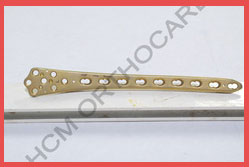Enriched by our vast industrial experience in this domain, we are involved in manufacturing and supplying the brand named HCM Orthocare Special Locking Plates products. The manufactured special locking plates are a form of internal fixation that is used in surgeries to hold fractures in place and allow them to heal at the correct place. Our manufactured special locking plates are fracture fixation surgical tools with threaded screw holes, which permit screws to thread to the plate and function as a fixed-angle device.
Different types of Special Locking Plates that we manufacture are as under
Locking Plate Manufacturer, Locking System Manufacturer in India
HCM Orthocare is a well known name in orthopedic implant manufacturing market. We are a prominent manufacturer, wholesaler, retailer, and exporter of different types of Locking Plates. The offered range is available in various sizes, patterns, designs, and dimensions as per the variegated requirements of our prestigious clients. As orthopedic surgery has evolved, trends in the treatment of supra and intercondylar femoral fractures now more commonly involve operative management. Distal Femoral Locking Compression Plate has a smaller application device and allows both locking and compression screw fixation of the femur shaft. Our products are well-tested by experts on every parameter including, durability, dimensional accuracy, optimum finish, minimum maintenance, hassle-free functionality, and robust construction. Our product range starts from 5 hole plate to 13 hole plate.

Cervical Cage with Plate
A prospective case series of 25 patients (30 operated discs) with a Cervical Cage with Plate treated with a zero-profile cage was constructed and followed up for an average of 16 months (range 12–18 months) in descriptive research. For arm and neck discomfort, the Neck Disability Index (NDI) and visual analog scale (VAS) scores were used to measure function. Our scheme based on gait impairments was also described. At 12 months after surgery, simple X-rays and, when necessary, a CT scan was used to confirm radiological fusion. The Bazaz criteria were used to classify dysphagia.
Cervical Spine Plate
The Cervical Spine Plate is designed with graft visibility windows, an anti-migration system, color-coded, self-drilling screws, and a low profile so they can be used for treating degenerative disc disease, trauma, tumors, deformity, pseudarthrosis, and failed previous fusions.
Features:
- Grafts can be observed more easily with a visibility window.
- Surgical bending is reduced by thelordotic design.
- Screws that is self-tapping for easy insertion.
- Easy identification through color coding.
Screws:
- 4.0mm locking screw
- 4.35mm emergency screw
Indications:
- Degeneration of the spine
- Traumatism
- Cancers
- Disfigurement (defined as kyphosis, lordosis, or scoliosis)Pseudarthrosis
- Previous fusion attempts that failed
Anterior Cervical Plates
On the front of the spine, a tiny plate might be put. This very simple treatment can significantly improve the spinal structure’s stability.
In the 1980s, anterior plates were created, and their application was initially limited to lengthy fusions (multi-level fusions). They are now being used by more surgeons for single-level surgeries.
An anterior cervical plate, which is used during surgery to preserve the bone graft and provide additional spine stability, does not add much to a cervical fusion treatment. The plates are costly, but they said in a faster return to normal function following surgery. Using a plate as a normal component of cervical fusion has become considerably more popular in recent years.
